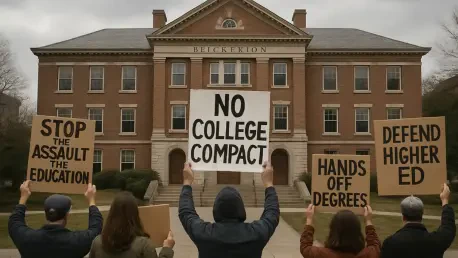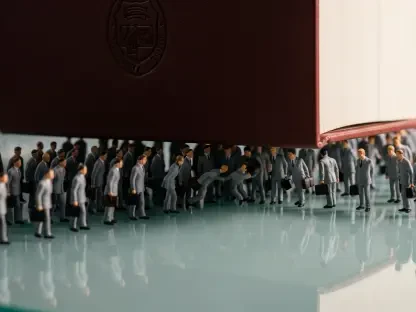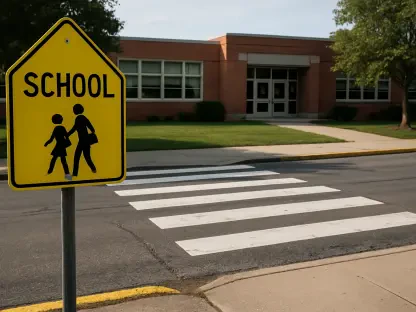As we navigate the evolving landscape of higher education policy, few voices carry as much weight as Camille Faivre, a renowned expert in education management. With a focus on innovative learning solutions in the post-pandemic era, Camille has dedicated her career to helping institutions adapt through open and e-learning programs. Today, we dive into a pressing issue shaking the academic world: the Trump administration’s proposed higher education compact. This controversial offer, extended to nine prominent universities, promises federal research funding in exchange for significant policy control, sparking fierce debate over academic freedom and institutional integrity. In this interview, we explore the compact’s implications, faculty reactions, legal concerns, and the broader impact on the future of higher education.
How would you describe the core idea behind the Trump administration’s higher education compact, and what stands out to you about its terms?
At its heart, this compact is a trade-off: universities gain preferential access to federal research funding, but in return, they must cede control over certain policies. It’s a deal that could reshape institutional autonomy, touching on everything from admissions to how faculty can engage in political discourse. What stands out to me is the breadth of control it seeks—reports suggest it could limit foreign student enrollment and even restrict how universities address issues like transgender rights. It’s framed as a partnership, but many see it as a mechanism for federal overreach into academic governance, which is traditionally a space of independence.
What has been the reaction from faculty and employee groups to this proposal, and why do you think it’s so polarizing?
The reaction has been overwhelmingly negative from faculty and employee groups. At institutions like the University of Virginia and the University of Arizona, faculty senates have voted decisively against it, with resolutions calling it a threat to independence and integrity. The polarization comes from a deep fear of losing academic freedom—there’s a sense that signing on could mean universities become pawns to governmental whims. I’ve heard vivid metaphors like “poisoned apple” being used, which reflects not just intellectual opposition but a visceral, emotional rejection of what many see as a betrayal of higher education’s core mission.
Can you shed light on the specific actions universities have taken so far in response to this offer?
So far, none of the nine universities offered this deal have publicly committed to accepting or rejecting it, which speaks to the complexity of the decision. Leaders at places like the University of Pennsylvania and Dartmouth have issued cautious statements, emphasizing their commitment to academic values while seeking input from their communities. There’s a clear tension between faculty pressure and administrative deliberation. The timeline is tight—feedback was due by mid-October, with a signing deadline in November—so we’re likely to see more definitive stances soon as internal discussions wrap up.
There’s been talk of legal concerns surrounding this compact. What are some of the key issues that experts have flagged?
Legal concerns are a major sticking point. Some analyses suggest the compact may violate state or federal laws, particularly because it lacks clarity on critical details. For instance, it threatens to cut federal funding for non-compliance but doesn’t specify which funds or under what conditions. This vagueness creates a minefield for universities—how do you weigh the risk when the consequences aren’t clear? There’s also the question of whether the administration has the statutory authority to offer “preferential access” to federal programs in this way. It’s a legal gray area that could deter institutions from signing on without ironclad assurances.
How do past interactions with the Trump administration color the way universities are approaching this compact?
Past dealings definitely play a role. Take the University of Pennsylvania, for example—they previously navigated a contentious agreement over Title IX interpretations related to transgender athletes, which involved significant concessions. Similarly, Brown University settled a $50 million deal over antisemitism claims, giving the administration oversight into admissions. These experiences create a backdrop of caution; universities might worry that agreeing to this compact locks them into a pattern of compliance under pressure. On the flip side, some might see it as a pragmatic way to secure funding, but the history of these interactions often breeds skepticism more than trust.
Critics have pointed to broader implications of this compact for higher education. What do you see as the most significant potential impacts?
Critics, including civil rights groups, argue that this compact could fundamentally alter the landscape of higher education. They’re concerned about restrictions on free speech, limits on international student enrollment, and policies that could marginalize certain student groups, like transgender individuals. Beyond that, there’s a fear of a chilling effect—universities might self-censor or avoid controversial research to stay in the government’s good graces. If adopted widely, this could erode the role of higher education as a space for open inquiry, turning institutions into extensions of political agendas rather than independent centers of learning.
Looking ahead, what is your forecast for the future of such policy interventions in higher education?
I think we’re at a crossroads. If this compact gains traction, it could set a precedent for more direct governmental influence over universities, especially in politically charged areas like admissions or curriculum. However, the strong pushback from faculty and unions suggests that institutions won’t go down without a fight. My forecast is that we’ll see a fragmented response—some universities might negotiate modified terms, while others outright reject it, potentially leading to legal battles. The bigger question is whether this sparks a broader movement to protect academic autonomy, or if financial pressures ultimately force more compliance. It’s a tension that will shape higher education for years to come.









